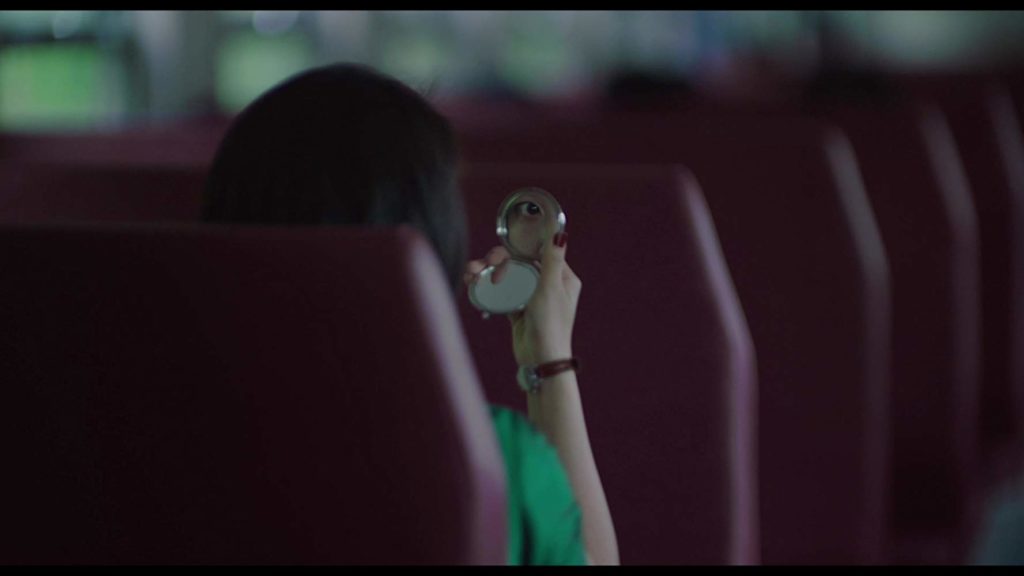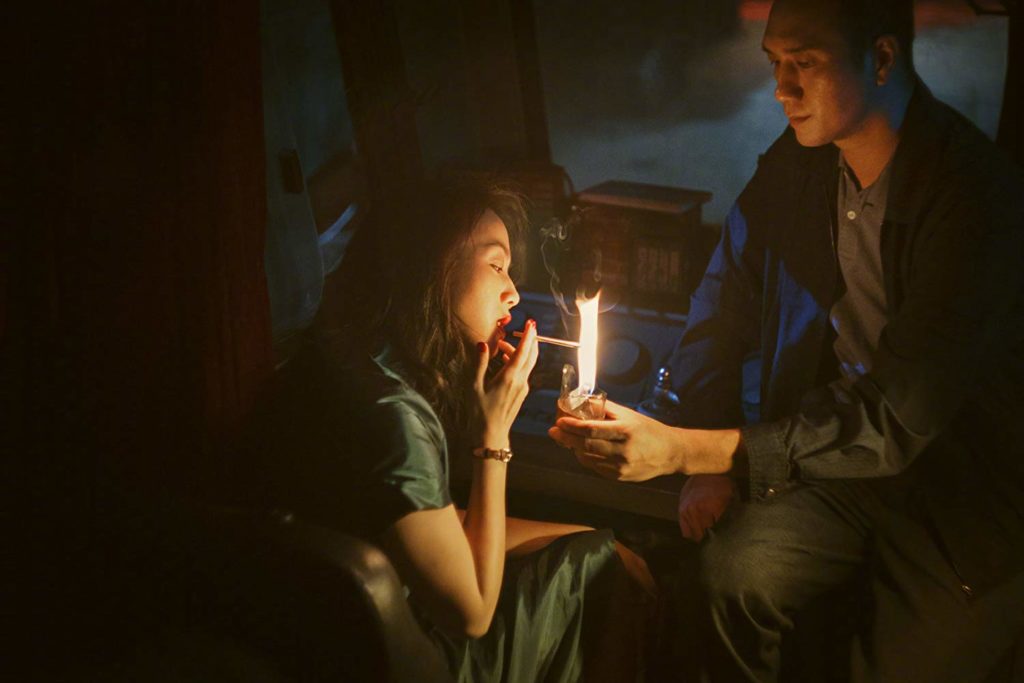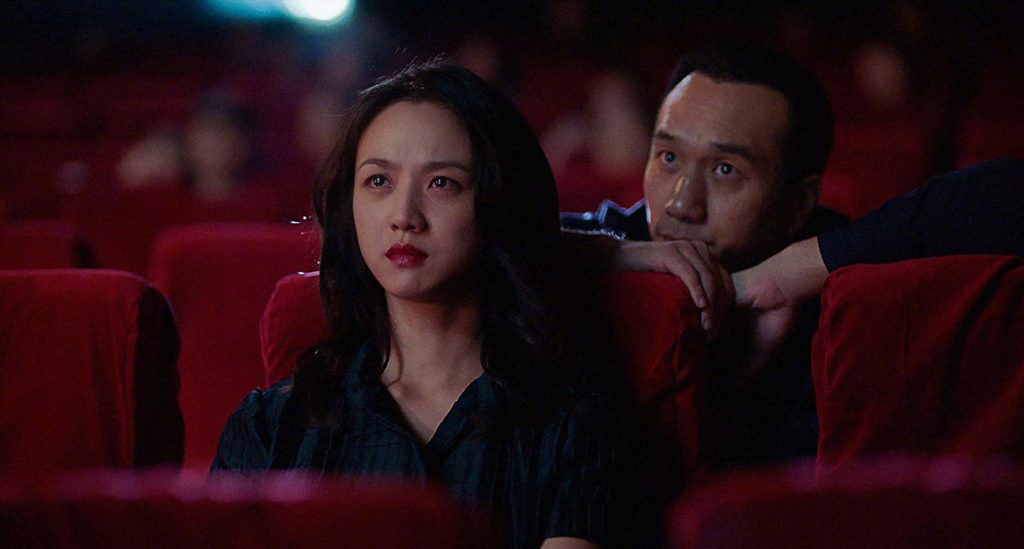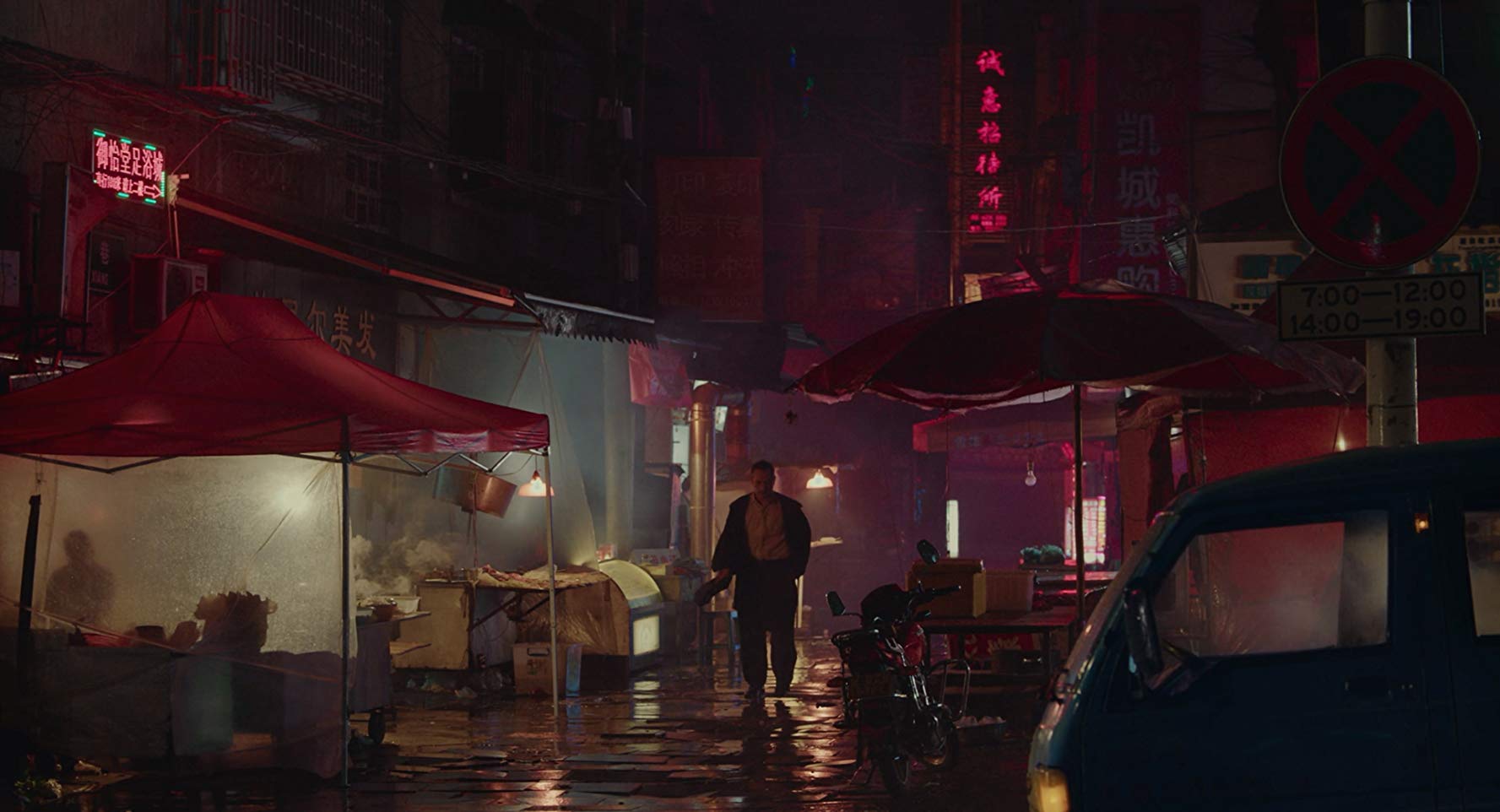A 3-D Dream of Lynchian Trappings and Directorial Assurance.
DIRECTED BY BI GAN/2019 (U.S. Theatrical Release)
BLU-RAY STREET DATE: DECEMBER 17, 2019/KINO LORBER

Amid a flurry of cinephile hubbub comes filmmaker Bi Gan’s Chinese Art House smash and oneirically obtuse noir, Long Day’s Journey Into Night (地球最后的夜晚 / Di qiu zui hou de ye wan).
Curiously, this dark and strange film claims nothing in relation to its English-language namesake by playwright Eugene O’Neill. Considering that O’Neill’s play is considered a canonized masterwork (his magnus opus, it is said; intensely personal and autobiographical), young auteur Bi Fan’s choice of title seems all the more brazen, perhaps not unlike a more antiquated version of naming his unrelated movie, say, “Star Wars”. (“Blade Runner” would be a greater fit, as select still frames of Long Day’s Journey could easily be mistaken for Ridley Scott’s own dystopian 2019). Yet, here we are in a cultural place in which few under the age of fifty are likely to recall O’Neill’s original, nor even its star-filled Sidney Lumet film adaption. Still though, the title is evocative. Potent. Familiar yet unfamiliar. Like something uttered in a half-forgotten dream.
Bruised yet enigmatic, Luo Hongwu (Huang Jue) has returned home to the small Chinese town of Kaili. Though a simple place, his visit is anything but. His purpose in being there is three-pronged: it’s his father’s funeral that brings him into town; the memory of his dead friend Wildcat is where his mind is, though it’s the search for his former lover, Wan Qiwen (Tang Wei), that is taking up his time and attention. Taiwanese superstar Sylvia Chang turns up as a hairdressing matriarchal figure of sorts. Crime is always in the fabric, the fabric often reflecting our protagonist.

Stoic, stiff, graying and quiet, Hongwu moves about Kaili adorned in the noir standard-issue overcoat, cigarette smoke often swirling around him. This is an internally bruised and damaged man; that much we can deduce without the help of a hired detective or screenwriter’s audio commentary. This Kaili seems to be a place of perpetual night, permanently straddling the visage of awake and asleep. Little is said but much is felt in this used-up present-time village. Bi Gan’s poetry is such:
A packed, moving bus become a temporary transport to the unknown, a singular shot, symmetrically framed and washed over by mystical streetlight. The pop-up structures of humble street markets assume a magical glow, lights halo-ing and reflecting compelling isolation in the ever-wet streets. The evocative curl of cigarette smoke, courtesy of a mystery girl in a shiny green dress, plunges us into a dispensed-with past in which smoking itself played wholly into femme fatale seduction- of both the male lead and the audience.
All of that is reason enough to consider Long Day’s Journey into Night a can’t miss cinematic experience. This first seventy minutes (give or take) is both the set-up and anchor of what is to follow, it’s true. But it’s also so much more. The crux of the hoopla surrounding this film has been focused almost wholly on its second half, a bold and unprecedented single fifty-minute-long unbroken shot, realized in immersive 3-D. It is a dream sequence (Luo Hongwu settles into a beat-up movie theater, donning a pair of stereoscopic viewers- a meta cue for real-life audience members to do the same- before finally, presumably, conking out), so whatever logic the film had been trading on is now officially off.

Enter the third dimension. As far as gonzo 3-D sequences go, this one is both the current king and a dialed back affair. The camera follows our protagonist into a remote area via handcart and then zip line. There’s a dance-off and a difficult billiards shot that has to happen. Lots of acting and wandering about in the sleepy non-reality of it all. Characters from the first part of the film return in other identities, like some kind of down-to-Earth Wizard of Oz. It’s a tremendously bold filmmaking undertaking that shows it months of planning. Also, though, it’s strangely reserved. There’s nothing in this dream that would cause one to lurch awake. The 3-D is almost entirely immersive, going for depth as opposed to the old gimmick hurling things at the viewer. It’s almost as though the Dardenne brothers dreamt this, as the camera follows Huang Jue from behind, at shoulder level. Never cutting, always in motion. As far as bravura cinema sequences go, this one is reservedly, respectfully modest. The result is key: even in 2-D, the experience is outstanding.
*****
Sometimes it takes a while for the celebrated esoterica of the annual Festival de Cannes to arrive stateside, if ever. In the case of Long Day’s Journey into Night, it’s taken a solid eighteen-plus months for the film to finally materialize on Blu-ray in the U.S. The release from Kino Lorber is well worth the wait. The film’s strikingly beautiful cinematography shines through in every moment. Colors are vivid, flame is vibrant. You won’t want to look away. Kino Lorber serves up in a two-disc set, containing a standard issue Blu-ray version (non 3-D), and, for those who invested in 3-D televisions and players during the brief window in which they were manufactured, there is also a 3-D Blu-ray Disc.
Kino Lorber’s new set manages to be both exquisite and fairly streamlined in quantity, its only other extras being a brief interview with star Huang Jue, and a “making of” featurette that is sadly only a couple minutes in length. As far as the relative newcomer Bi Gan is concerned, Kino Lorber’s bonus content is revealing in several different ways. In a short ten-minute video supplement, he tells of how he is influenced by video games, declaring himself “an avid gamer”. This question came in the interest of dissecting the inspiration for the film’s long take, particularly the way the camera simply follows characters for long stretches of time without cutting. This is where the afore-mentioned Dardenne’s aesthetic collides with attention-addled perception of gamers, blending the seeming extremes in a bold, unforeseen-but-obvious singularity.

In the four-color booklet that comes with the two-disc set, Bi Gan describes himself as a regular guy, living in a small town with his wife and kid. He’s also revealed to be quite a humorous guy, an aspect of his personality that does not come through in Long Day’s Journey into Night. Granted, this film is excellent the way it is. But upon reading this multi-part published question and answer session with interviewer Aaron Stewart-Ahn, one can’t help but hope for a comedy in the director’s future.
Long Day’s Journey into Night has finally arrived on Blu-ray (subtitles in English from Mandarin Chinese); it’s important that film buffs not doze through this news. As a filmic mystery of the David Lynchian variety, Bi Gan’s accomplishment cannot be all things to all audiences. Conventional resolution is traded for total immersion, a more-than-fair trade considering that the viewer saves the cost of a trip to Kaili and is granted access into the mind of an emerging major auteur talent.
The film reinforces fleeting notions that one’s past can be dangerous, and dreams aren’t always the wonderful movie stories that take us over the rainbow. Like O’Neill, we can look back and artistically dig into our troubled past. But like Bi Gan, while looking back so many years on, we can also see replicant hints of a collective past we carry but can summon little knowledge of. (Such as, perhaps, the work of Eugene O’Neill). Sometimes, they’re a damp path that leads us in circles as the scenery free-riffs around us. Such is this Long Day’s Journey into Night; one of the finest films of the year.



